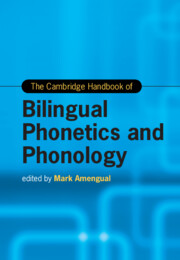Book contents
- The Cambridge Handbook of Bilingual Phonetics and Phonology
- Cambridge Handbooks in Language and Linguistics
- The Cambridge Handbook of Bilingual Phonetics and Phonology
- Copyright page
- Dedication
- Contents
- Figures
- Tables
- Contributors
- Acknowledgments
- Introduction Bilingual Phonetics and Phonology
- Part I Approaches to Bilingual Phonetics and Phonology
- Part II Theoretical Models of Bilingual Phonetics and Phonology
- Part III The Phonetics and Phonology of the Bilingual Child
- Part IV The Phonetics and Phonology of the Bilingual Adult
- Part V The Diversity of Bilingual Speakers
- Part VI Variables and Outcomes of Bilingual Speech
- 29 Language Dominance Effects in the Phonetics and Phonology of Bilinguals
- 30 Code-Switching and Language Mode Effects in the Phonetics and Phonology of Bilinguals
- 31 Orthographic Effects in the Phonetics and Phonology of Second Language Learners and Users
- 32 Phonetic and Phonological L1 Attrition and Drift in Bilingual Speech
- 33 Bilingual Speech Intelligibility
- 34 Using a Characteristic Speech Production (CSP) Procedure to Elicit Monolingual and Bilingual Speech
- 35 Bridging the Gap between Bilingual Phonetic Research and Pronunciation Teaching
- Index
- References
31 - Orthographic Effects in the Phonetics and Phonology of Second Language Learners and Users
from Part VI - Variables and Outcomes of Bilingual Speech
Published online by Cambridge University Press: 14 November 2024
- The Cambridge Handbook of Bilingual Phonetics and Phonology
- Cambridge Handbooks in Language and Linguistics
- The Cambridge Handbook of Bilingual Phonetics and Phonology
- Copyright page
- Dedication
- Contents
- Figures
- Tables
- Contributors
- Acknowledgments
- Introduction Bilingual Phonetics and Phonology
- Part I Approaches to Bilingual Phonetics and Phonology
- Part II Theoretical Models of Bilingual Phonetics and Phonology
- Part III The Phonetics and Phonology of the Bilingual Child
- Part IV The Phonetics and Phonology of the Bilingual Adult
- Part V The Diversity of Bilingual Speakers
- Part VI Variables and Outcomes of Bilingual Speech
- 29 Language Dominance Effects in the Phonetics and Phonology of Bilinguals
- 30 Code-Switching and Language Mode Effects in the Phonetics and Phonology of Bilinguals
- 31 Orthographic Effects in the Phonetics and Phonology of Second Language Learners and Users
- 32 Phonetic and Phonological L1 Attrition and Drift in Bilingual Speech
- 33 Bilingual Speech Intelligibility
- 34 Using a Characteristic Speech Production (CSP) Procedure to Elicit Monolingual and Bilingual Speech
- 35 Bridging the Gap between Bilingual Phonetic Research and Pronunciation Teaching
- Index
- References
Summary
This chapter reviews evidence that the orthographic forms (spellings) of L2 sounds and words affect L2 phonological representation and processing. Orthographic effects are found in speech perception, speech production, phonological awareness, and the learning of words and sounds. Orthographic forms facilitate L2 speakers/listeners – for instance in lexical learning – but also have negative effects, resulting in sound additions, deletions, and substitutions. This happens because L2 speakers’ L2 orthographic knowledge differs from the actual working of the L2 writing system. Orthographic effects are established after little exposure to orthographic forms, are persistent, can be reinforced by factors other than orthography, including spoken input, and are modulated by individual-level and sound/word-level variables. Future research should address gaps in current knowledge, for instance investigating the effects of teaching interventions, and aim at producing a coherent framework.
Keywords
- Type
- Chapter
- Information
- The Cambridge Handbook of Bilingual Phonetics and Phonology , pp. 699 - 720Publisher: Cambridge University PressPrint publication year: 2024

